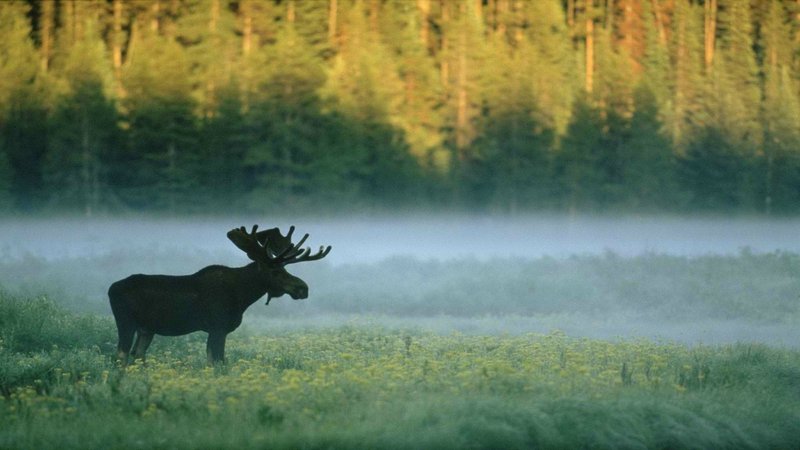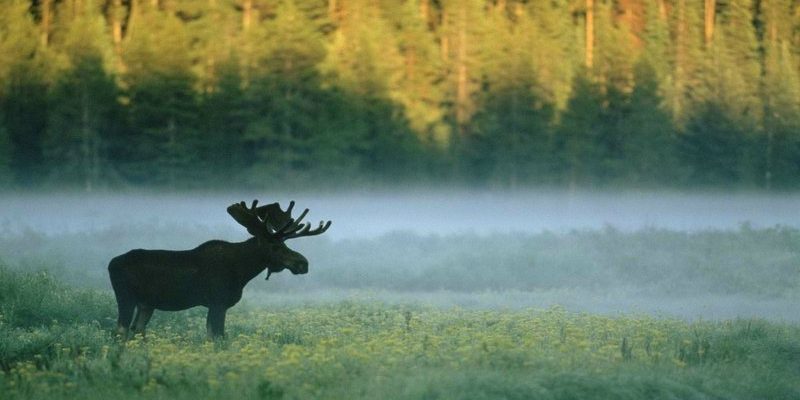
What is a Moose?
Moose are fascinating creatures that often capture the imagination of those who encounter them. Imagine a stately giant, standing as tall as a horse, with long legs and an impressive set of antlers on the males. These remarkable animals are the largest members of the deer family and are primarily found in the northern parts of North America, Europe, and Asia. They thrive in cold climates, where their large bodies and thick fur keep them warm.
These majestic animals are more than just large and lumbering; they also possess unique behaviors and adaptations that help them survive in their environments. Their long legs are designed for moving effortlessly through deep snow, while their impressive antlers serve as tools for dominance during mating season. If you’ve ever been curious about these gentle giants, you’re in for a treat. In this article, we’ll explore everything from their physical characteristics to their diet and habitat.
Physical Characteristics of Moose
Moose are remarkable animals with features that truly stand out. On average, an adult moose can weigh between 800 to 1,600 pounds! Their height can reach up to 6.5 feet at the shoulder, while their antlers, which can span up to 6 feet across, make a striking presence. Males, known as bulls, have large, broad antlers that they shed and regrow annually. The process of antler growth is fascinating, as they develop from a soft tissue known as velvet, which eventually hardens.
In terms of appearance, moose have a long, horse-like head with a large, hanging nose. Their bodies are thick and heavy, with a distinctive hump on their shoulders. The fur of a moose is typically dark brown or black, helping them blend into their natural surroundings—a clever adaptation for avoiding predators. The combination of their impressive size and unique features makes moose one of the most recognizable animals in the wild.
Where Do Moose Live?
Moose primarily inhabit regions with cold climates. They are commonly found in Canada, Alaska, Scandinavia, and parts of Russia. These large mammals prefer areas with abundant food sources, such as wetlands, rivers, and forests. You’ll often spot them near lakes and ponds, where they can feed on aquatic plants. Their preference for dense forests provides them with cover from predators like wolves and bears.
Moose are also known to migrate seasonally. As colder months approach, they may move to lower elevations to escape heavy snowfall, making their foraging easier. Their strong legs help them navigate through deep snow, but they will travel to find food sources when necessary. This adaptability is key to their survival, allowing them to thrive in even the harshest conditions.
Moose Diet and Feeding Habits
When it comes to food, moose are herbivores, which means they primarily eat plants. Their diet changes with the seasons. In warmer months, they enjoy a variety of leaves, twigs, and shoots, while in winter, they rely on the bark of trees, particularly willow and birch. They are also known to dive underwater to reach aquatic plants, which can be a surprising sight!
Moose can consume up to 60 pounds of food each day. They have a four-chambered stomach, which allows them to digest tough plant materials efficiently. This unique digestive system plays a crucial role in their overall health and well-being. You might be wondering how they manage to find enough food during the winter. Well, moose have an incredible sense of smell that helps them locate food even under layers of snow.
| Feature | Detail |
| Weight | 800 – 1,600 pounds |
| Height | Up to 6.5 feet |
| Antler Span | Up to 6 feet |
| Habitat | Cold climates (Canada, Alaska, Scandinavia) |
| Diet | Herbivore (leaves, bark, aquatic plants) |
Moose Behavior and Social Structure
Moose are generally solitary animals, which sets them apart from many other members of the deer family. While you may occasionally see groups of females (cows) and their calves together, adult bulls prefer to roam alone, especially outside the mating season. This solitary behavior allows them to avoid conflict and competition for resources.
During the mating season, known as the rut, bulls become more social. They engage in displays of strength, often clashing their antlers in a show of dominance to attract females. This can be a dramatic sight, as the deep sounds of their belligerent interactions echo through the forests. After the rut, bulls will usually return to their solitary nature until the next breeding season.
Moose communicate using a variety of vocalizations, including grunts, bellows, and moans. These sounds play a role during the mating season but can also be used in other contexts, such as warning others of danger or attracting attention.
Predators and Threats to Moose
Despite their size and strength, moose face threats from various predators. Wolves are among the most significant threats, often hunting in packs to take down larger prey like moose. Bears, particularly when cubs are present, may also pose a danger, though they typically prefer smaller animals. As massive as they are, adult moose can be vulnerable, especially when weakened by harsh winter conditions or illness.
Human activity presents another major threat to moose populations. Habitat destruction due to logging, urban development, and road construction can severely impact their living spaces and food sources. Vehicle collisions with moose are also a common problem, and these incidents can be dangerous for both the animals and drivers. Conservation efforts are crucial in protecting these magnificent creatures and ensuring their survival for future generations.
Interesting Facts About Moose
If you think you know everything about moose, think again! Here are some fun and intriguing facts that might surprise you.
– Moose have a special adaptation in their long legs that allows them to walk easily through deep snow, making them well-suited for their cold, northern habitats.
– A moose’s tongue can be up to 20 inches long! They use it skillfully to grasp food, particularly when reaching for high leaves or underwater plants.
– Their eyes are positioned on the sides of their heads, giving them a wide field of vision to spot predators, though they still have a blind spot directly in front of their nose.
– Baby moose, called calves, are born in the spring and can stand and walk within minutes of being born, a vital skill for escaping predators.
You might think these facts are just quirky details, but they paint a larger picture of how uniquely adapted moose are to thrive in their environments.
Moose in Culture and Popularity
Moose have become symbolic animals in many cultures, often representing strength, endurance, and wilderness. They feature prominently in folklore, art, and even logos for various companies, reflecting their status as iconic wildlife. In North America, they are a draw for wildlife tourism, with many enthusiasts traveling to witness these magnificent animals in their natural habitats.
In some regions, moose are also celebrated through festivals and events that honor their significance to local cultures and ecosystems. They serve as an important reminder of the beauty and complexity of wildlife, highlighting the need for conservation efforts to protect these creatures and their habitats.
If you ever get the chance to see a moose in the wild, consider yourself lucky! Observing their behaviors and interactions in their natural environment can be a truly unforgettable experience.
FAQ
What is the average lifespan of a moose?
Moose typically live for about 15 to 25 years in the wild, although some individuals have been known to reach over 20 years. Their lifespan can be influenced by various factors, including habitat quality, food availability, and predator presence. In some areas, where they have fewer natural predators and abundant food sources, moose can live longer, healthier lives.
Are moose dangerous to humans?
While moose are generally not aggressive towards humans, they can become dangerous if they feel threatened or cornered. During the mating season, bulls can be particularly territorial and may react defensively if approached. Additionally, moose are large animals, and vehicle collisions can be fatal for both the moose and the driver. It’s essential to keep a safe distance and avoid approaching them in the wild.
How fast can a moose run?
Moose are surprisingly fast for their size! They can run at speeds of up to 35 miles per hour (56 kilometers per hour) in short bursts. Despite their bulk, they are agile and can navigate through rough terrain quickly, especially when escaping from predators or humans.
Can moose swim?
Yes, moose are excellent swimmers! They can swim for long distances, using their long legs and powerful shoulders to paddle through water. Moose are often seen swimming between islands in lakes and rivers, and they can dive underwater to feed on aquatic vegetation.
Do moose have any natural predators?
Yes, moose do have natural predators, primarily wolves and bears. Wolves tend to hunt in packs, making them effective hunters, especially when capturing calves. In some regions, mountain lions may also pose a threat to moose. However, adult moose can often defend themselves against most predators due to their size and strength.
How do moose adapt to cold climates?
Moose are well-adapted to cold climates with their thick fur coats that insulate them well during harsh winters. Their large size helps conserve heat, and they have a unique circulatory system that minimizes heat loss. Additionally, their long legs allow them to walk through deep snow, making it easier for them to find food when temperatures drop.
Are all moose the same species?
Moose belong to the species Alces alces, but there are several subspecies that vary by geographical region. The most well-known subspecies include the Eastern moose, Western moose, and Shiras moose. Each has its own unique characteristics, adaptations, and habitats, but they all share the general traits that make moose so fascinating.
What do baby moose eat?
Baby moose, or calves, primarily drink their mother’s milk during the first few months of their lives. As they grow, they start to nibble on tender vegetation, leaves, and shoots. By the time they are about 3 to 4 months old, they begin to eat a more varied diet similar to that of adult moose, gradually transitioning to a fully herbivorous diet.
How do moose communicate?
Moose communicate through various vocalizations, including grunts, bellows, and moans. During the mating season, bulls use loud calls to attract females and establish their territory. Beyond vocal sounds, they also communicate through body language, using their size and posture to convey messages to other moose.
Are moose social animals?
Moose are generally solitary creatures, especially outside of the mating season. However, female moose (cows) may form small groups with their calves for protection. Bulls are typically more solitary except during the mating season when they compete for females. This independent behavior allows them to reduce competition for resources and maintain their own territories.

